When travelling longer distances, whether across a country or across an ocean, often the best transport option is to fly. But what about if you’re travelling with a dog? Can you take dogs on planes? And how do you fly with a dog?
Luckily, dogs are indeed often allowed on planes, with a wide variety of airlines that allow dogs onboard. Depending on the size of your dog and your location, your dog might fly in the cabin or in the hold, and it’s not usually too complicated.
After travelling internationally with my Miniature Dachshund, I’ve experienced both flying with a dog in the cabin and in the hold. My dog has flown in the cabin in Europe and the USA, plus across the Atlantic. He’s also flown in the hold as cargo, when flying to and from Australia and domestically in Australia.
I’ll take you through everything you need to know about how to fly with a dog, from the various rules that apply to the cost of flying a dog to tips to prepare your dog for their first flight.
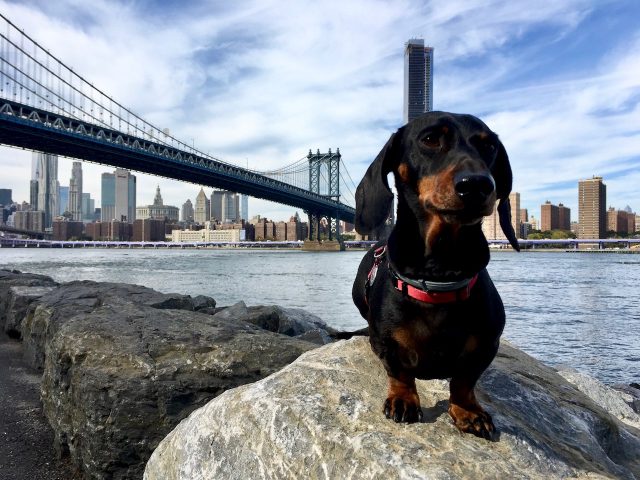
Flying with Pets in the Cabin
The easiest way to fly with a dog is in the cabin. Unfortunately, this option is generally limited to smaller dogs (if flying on commercial flights), and other small pets such as cats, and only in certain regions of the world.
The two main regions of the world where pets are allowed to fly in the cabin are Europe and the Americas. Often this is due to government regulation. For instance, it is not allowed in the UK, plus up until recently in Australia. Additionally, it’s also up to the individual airline.
For listings of airlines around the world that allow pets to fly in the cabin, check out my guides:
- US airlines that allow dogs to fly in the cabin
- Canadian airlines that allow dogs to fly in the cabin
- North & South American airlines that allow dogs to fly in the cabin
- Asian airlines that allow dogs to fly in the cabin (a short list…)
- Middle Eastern airlines that allow dogs to fly in the cabin
- European airlines that allow dogs to fly in the cabin
I’ve also put together a list of the most pet-friendly airlines in the world. With these airlines, as well as allowing pets in the cabin at a minimum, they also offer additional pet-friendly features, whether the ability to buy seats, higher weight limits or allowing your to check pet strollers for free.
When your pet flies in the cabin, they need to fit in a small dog carrier bag underneath the seat in front of you. Be prepared to have no leg room! Due to this, only small dogs are able to fly in the cabin. Sometimes just the maximum dimensions of the bag are specified, but often there is also a weight limit, most commonly 8kg (17.5 pounds).
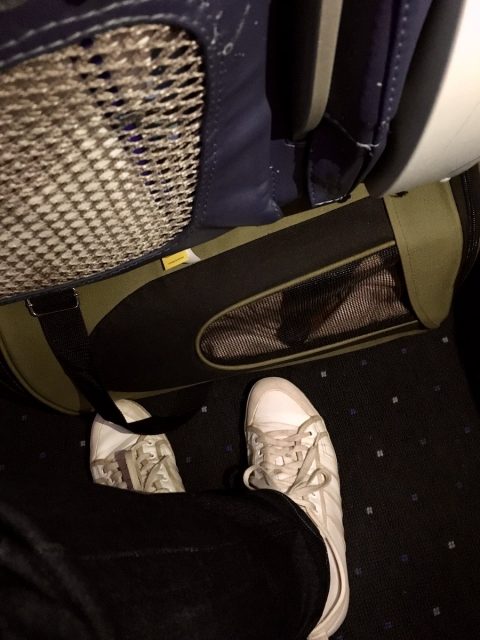
The process to fly with your dog in the cabin is quite straightforward. The trickiest part is often booking the flight. Sometimes this can be done online, as simple as if you were selecting to add a piece of luggage to your booking. Other times it needs to be done via the call centre, in which case you should call up first and confirm your pet can fly on the flight, before booking your own tickets.
When heading to the airport, take your pet with you in their carrier bag to the check-in counter. (Usually you can’t check-in online if you’re travelling with a pet.) At the counter they might weigh your pet. Then just keep your pet with your when you board the plane.
In January 2023, IATA (the International Air Transport Association), introduced a new In-Cabin Live Animal Acceptance Checklist, that may be reviewed and completed by the airline agent at the check-in counter. I recommend reviewing this and ensuring everything can be checked off ahead of time, although as of January 2025 I still don’t believe it’s commonly used. Additionally, I have been told that US domestic agents already have their own questionnaire.
For more details on the process of flying with your dog in the cabin, check out my guide for Europe.
Can I Buy a Seat for My Dog on an Airplane?
Often people who have larger dogs that aren’t small enough to fit in the plane carrier bags ask whether they can buy a seat for their dog on the flight. Surely if their dog can take up the space of a seat or in front of a seat they can fly in the cabin?
Unfortunately though, generally airlines don’t permit you to buy a seat for your dog on an airplane. There are only a small number of exceptions amongst commercial flights.
In the USA, JSX permits an adjoining seat to be purchased for medium and large-sized dogs that are too large to fit in the regulation under-seat pet carriers, but still 65 lbs (29.5kg) or less. In this case, the dog is not permitted to sit on the seat, but must sit on the floor in front of it. JSX flies a growing number of routes in the USA, plus to Cabo San Lucas in Mexico.
Etihad Airways, one of the few Asian airlines that allows pets to travel in the cabin, gives the option of buying an adjacent seat when flying in economy, or requires you to buy a seat if you are flying with a pet in business or first class. In both cases, a larger carrier bag is permitted, but the weight limit remains 8kg.
While most European airlines don’t allow seats to be purchased, one Russian airline, S7 Airlines, does provide the option to book a seat for your pet. If booking a seat, your pet and its carrier can weigh up to 23kg combined, although a rigid carrier is also required. For more details, see their website. More recently, the Belarusian flag-carrier, Belavia, started to offer a similar option.
For the latest and complete list, check out my full guide to airlines that allow you to buy a seat for your dog, including some airlines that allow you to buy a second seat so you can fly two pets.
What About Emotional Support Animals?
Previously, if you lived in the USA and had an emotional support animal, they were generally allowed to fly in the cabin with you on US airlines, at no additional charge, regardless of the size of the pet.
However, in recent years this practice has been curtailed. It is now up to the individual airline and virtually no US airlines continues to allow emotional support animals to fly for free. Only service animals can fly free of charge, plus emotional support animals are permitted in the cabin if they fit into the criteria for pets to fly in the cabin, for a charge of course.
For airlines outside of the USA, the acceptance of emotional support animals was generally quite limited, often only on flights to and from the US.
It’s best to carefully check the pet policy of individual airlines if you have an emotional support animal. When I last checked, a number of Canadian, Mexican and South American airlines still allowed emotional support animals, though usually only dogs and sometimes with a weight limit of 10kg.
If you have a recognised service animal, such as a guide dog, they are still permitted to travel in the cabin on most airlines free of charge. However, the regulations for service animals differ from country to country, in particular what is recognised as a service animal. Check with your airline for their regulations and paperwork requirements well in advance.
Flying Pets on a Chartered Flight
Another option for flying with your pet in the cabin, including larger dogs and parts of the world where this is not normally permitted, is to fly on a chartered flight. Be warned in advance though, these flights are expensive – generally starting around $8,000 USD on international routes for one person and one dog and steeply rising.
There are two options for chartered flights – organise your own, or join an existing chartered flight with other pet owners. The latter is more affordable, especially if the plane is fully booked. Some companies also offer a cheaper option to just fly your pet on the charter flight, under the supervision of chaperones.
There are a number of companies that have started to organise semi-regular flights for pet owners. Check out these options:
- Skye Pet Travel – Flights between Europe, the UAE, Australia and New Zealand
- K9 Jets – Flights between the USA, Europe and the UAE
- Bark Air – Flights between the USA and Europe
- VIP Pet Air – Flights between the USA and UK
Check out the upcoming flight schedules for these companies and get a quote for your pet. Alternatively, join this Facebook group, which organises joint chartered flights, including if your destination isn’t serviced by the above companies.
Flying a Pet in the Hold
Generally, if your dog is too small to fly in the cabin of a plane, dogs on planes are required to fly in the plane hold.
This isn’t as scary as it sounds. Reputable airlines for transporting animals have a special cargo hold area for live animals, that is temperature and pressure controlled, maintaining a similar temperature and pressure as for the passenger cabin, with dimmed lighting.
Plus the crate sizes required for pets to fly in ensure there’s plenty of room for them to stretch out and have a sleep, especially if your dog is not quite small enough to fit in the carrier sizes appropriate for flying in the cabin.
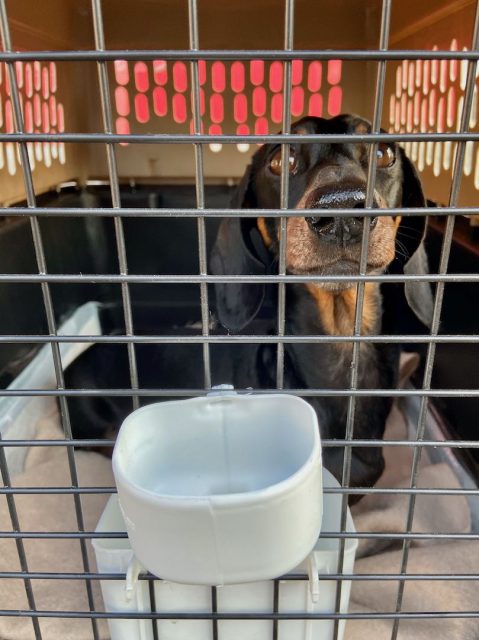
Unfortunately, there is no access from the passenger cabin of the plane to this cargo hold area during the flight, so you can’t check up on their journey, but on the other hand they have minimal disturbances.
Of course, it’s always best to go with an airline with a good reputation for transporting pets, that can provide you with details of their animal transport, and that you can trust for loading and unloading your pet safely. They will also not accept pets on flights with unsuitable aircraft.
Most of the time when pets travel in the hold of a plane they simply travel as “checked baggage”. In this case their treatment is handled similar to your suitcase. You check-in your pet at the check-in counter in their crate, and in the baggage collection area at the other end you head to the special baggage collection area.
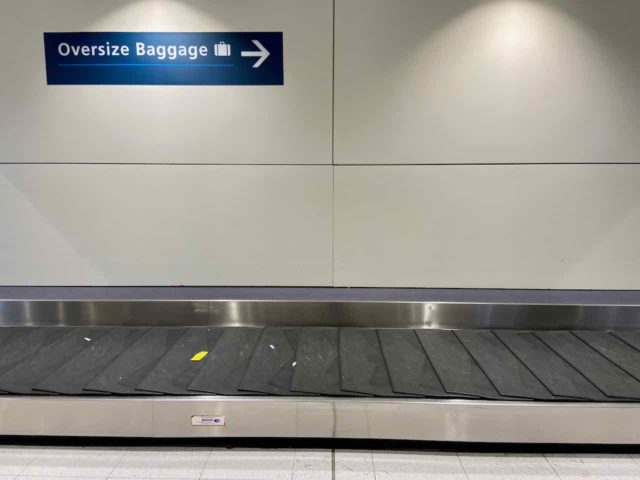
Flying a Pet as Cargo
There’s one final way that pets fly on planes: as cargo. Pets most commonly fly as cargo when this is a government requirement for the transport of pets.
For instance, pets flying into the UK are required to travel as cargo; they are not permitted to fly in the cabin or simply as checked baggage, so that the necessary custom checks can be done. Another country where all airlines require pets to travel as cargo is Australia.
The other situation where a pet might be required to travel as cargo is in the case of flying with a large dog. The weight limit for pets to travel as checked baggage differs between airlines, but can be as low as 32kg (70 pounds). Considering that this also needs to include the pet’s crate, this is quite low indeed.
For pets flying as cargo, the conditions during the flight are the same as for pets flying as checked baggage. Both fly in a special cargo hold of the plane.
The main difference is that pets flying as cargo need to be booked through the cargo or freight division of the airline, generally over the phone. You will also need to drop off your dog and pick them up from the freight facility, which can be a long way from the passenger terminal.
For a description of what it’s like to fly dogs in cargo, check out my post about flying dogs in Australia.
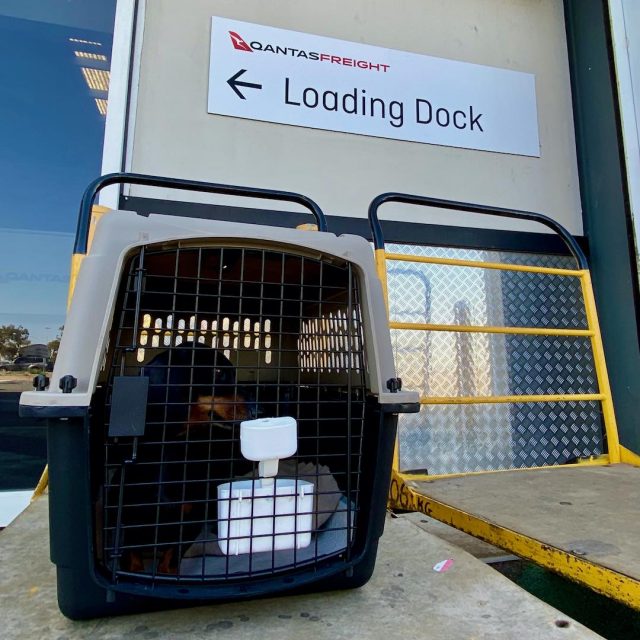
Should I Use a Pet Transport Company?
If you are flying with pets in cargo, you may be required to use a pet transport company. This is a company specialised in the transport of animals, who looks after booking your pet’s flight, delivering them to the freight terminal and picking them up after the flight. They can usually look after veterinary appointments and government paperwork for your pet, too.
You may also consider using a pet transport company even if you are not required to, particularly on flights with stopover or to countries with complex entry requirements. A pet transport company should know the rules, so you don’t need to stress about them.
They might be able to help with logistics, such as picking up and dropping off your pet. They can also help out in scenarios such as a flight being cancelled.
In different scenarios, I have both used a pet transport company and looked after everything myself. For instance, when I firstly flew overseas with my dog to Europe, I used a pet transport company. But when I undertook the difficult process of returning home to Australia, I looked after everything myself (a very stressful experience!)
For more details, check out my guide on using a pet transport company.
Key Questions on Flying with a Dog
Not surprisingly, a lot of questions are asked about flying with a dog. Here are some answers to the most common questions…
How Much Does it Cost to Fly a Pet?
The cost to fly a pet greatly varies depending on the size of the pet (or more actually, their crate), the flight route (longer routes are naturally more expensive), and whether they’re flying in the cabin, the hold or as cargo.
Generally, I’ve found the cheapest rates for pets are charged by European budget airlines flying pets in the cabin on short-haul flights. For instance, Pegasus Airlines in Turkey charges about €12 ($12 USD) for pets in the cabin on domestic flights. A pet fee of €40-60 ($41-$61 USD) is typical for eastern European airlines, although many of the rates charged have jumped in recent years.
For other European airlines, pets flying in the cabin are typically charged about €60 ($61 USD) for short-haul flights, and around €110 ($113 USD) on long-haul flights.
Pets flying on domestic flights in the United States are typically charged higher rates than in Europe, reflecting the longer distances involved, plus fewer airlines. A pet fee of $100-125 USD (about €98-122) for pets flying in the cabin on domestic flights is more typical.
The rates for pets flying in the hold are usually always higher than for pets flying in the cabin. This reflects the larger size of pets travelling in the hold, especially once you include the hefty crates used to transport pets in the hold. Often there are stepped rates for different size crates.
The most expensive option for flying pets is generally to fly them in cargo. When flying my 5kg (11 pounds) dog from Los Angeles to Melbourne in cargo in 2018, his flight cost $1314 AUD (over $900 USD at the time), more than either of our expensive one-way tickets.
Also note that when flying cargo, there’s also sometimes other costs involved, such as customs charges or the fees to use a pet transport company.
Are All Dog Breeds Allowed to Fly?
Before booking a flight for your pup, you also need to take into considerations breed restrictions.
The most common restrictions are for snub-nosed or brachycephalic breeds travelling in the hold, as these breeds are more likely to experience breathing difficulties and heat stress in this environment.
Some airlines flat out refuse to fly these dogs in the hold, while other airlines may have additional requirements, such as flying in a larger crate, obtaining a health certificate or signing a waiver. Always consult with your veterinarian about the health of your individual pet.
These restrictions don’t usually apply in the cabin (although always double check, a handful of airlines have restrictions or require an extra form). Its tough if you have a snub-nosed dog and they’re just over the size limit to fly in the cabin!

Some airlines also have restrictions for so-called dangerous breeds, such as pit bulls. Some dog breeds may be forbidden from flying on the airline, while other times special extra-strong crates may be required.
Other animals that have restrictions on flying include large breed dogs (some airlines cannot handle larger crates, and they might be required to fly as cargo, if offered), young puppies (minimum ages can be as high as four or six months for some airlines) and pregnant dogs.
The list of affected animals differs between airlines, so always look at the rules for the specific airline that you are considering flying with a dog.
What is the Weight Limit for Dogs on Planes?
There is no one single weight limit for dogs on planes, with the maximum weight for pets to fly in the cabin differing between airlines, in particular different parts of the world.
On European airlines, the most common weight limit for pets flying in the cabin is 8kg, including the carrier. (And as most carriers weight at least 1kg, this means the maximum weigh of the dog is actually 6-7kg.)
A handful of airlines have a higher weight limit, usually 10kg, or don’t include the carrier in the weight limit. However, there are also some airlines that have a lower weight limit, such as 6kg.
The situation is quite different with US airlines. The majority of American airlines don’t have a weight limit for pets in the cabin, just a maximum carrier size. However, there have been recent reports that more airlines are making sure that pets can fully stand in their carriers, to be allowed onboard.
Some other airlines in Canada and the rest of the Americas also don’t have a weight limit. Out of the remaining airlines in the North and South America, the most common weight limit is 10kg, higher than is normal in the US.
Weight limits also apply for pets flying as checked baggage, the same as there is a maximum weight suitcase that most airlines will accept. Larger dogs again usually need to fly as cargo, with the weight limits for cargo usually being far higher.
For a more thorough discussions of this topic, see my post about weight limits for dogs on planes.
What About Flying in Summer?
If your pet is flying in the cabin in summer, it’s no different to flying at any other time of year. Both yourself and your carry-on pet are usually in an air-conditioned terminal until boarding starts, then on an air-conditioned plane. You can monitor their comfort at all times.
But when your pet is flying in the hold during summer, it’s a different story. The biggest risk isn’t actually when they are up in the air, as the pet hold of the plane is air-conditioned. The biggest risk is when they are being loaded and unloaded onto the plane, potentially sitting around on the hot tarmac with extreme temperatures, especially if there’s delays.
For this reason, many airlines don’t fly pets during the summer months of the year. This most often happens in the USA, with certain cities. In other parts of the world, there are recommendations to fly with your pet outside of the hottest period of the day, and not on especially hot days. Which can be difficult as no-one can perfectly forecast the weather, especially when you’re planning months in advance!
If you will be flying your pet in the summer, I recommend booking a flight for early or late in the day, ideally with the option to be flexible if you need to reschedule due to the temperature. It’s best to avoid transit stops – instead select a direct flight. Make sure your dog has plenty of water and try to drop them off as late as possible.
Brachycephalic, or snub-nosed, breeds, are in particular prone to breathing difficulties and are sensitive to hot conditions. For this reason, many airlines don’t accept snub-nosed breeds for flights in the hold, or have extra restrictions, including in relation to temperature. Try to find another option to get to your destination that doesn’t involve flying.
Finally, find a reputable airline that you can trust, but remember the ultimate decision on the day sometimes comes down to you.
Is it Safe for Pets to Fly in the Hold?
Flying pets in the hold of a plane is not without a slight risk. There have been some incidents over the years. So, it’s no surprise that many pet owners stress about putting their beloved pet in the hold of a plane to fly, whether as excess baggage or cargo.
I’ve flown multiple times with my pet in the hold with an issue, and know of many other pet owners who have had no issues when flying their pets in the hold. However, consider these three things to minimise the risk:
- Breed and Age of Pet: The pets with the greatest risk of something happening when they fly in the hold are brachycephalic or snub-nosed breeds. For this reason, many airlines will not fly these animals in the hold. Older animals are also at greater risk. Carefully consider your pet’s health and whether they can handle flying in the hold. In if doubt, speak to your vet.
- Avoid Temperature Extremes: The most dangerous conditions for pets to fly in the hold are during the hot days of summer. Issues can happen when pets are left in the tarmac during hot weather when flights are delayed. Not surprisingly, some airports and airlines have embargoes during certain months of the year. Extreme cold is also risky for pets. Try to fly with your pet when the weather is more mild.
- Crate Train: The other pro-active step you can take to minimise any risk to your pet is to crate train your pet in advance. If they’re comfortable and happy at being in their crate, they’re less likely to be stressed during the flight.
The question of sedation regularly comes up, but most airlines recommend never to sedate dogs when flying, as this actually increases the risk that they might have trouble breathing during the flight. If you think your dog needs a treatment to help them relax, speak to your vet and trial in advance.
Preparations for Flying a Pet
Before flying with your dog for the first time, whether in the cabin or the hold, it is essential that you prepare them for the experience. This will help reduce their anxiety during the unusual experience, plus reduce your own stress levels.
Familiarising Your Dog with their Crate
The biggest way you can help your pet is by familiarising them with their carrier or crate ahead of time. It helps if they’ve been crate trained from a young age, but if not just start well before their flight.
Purchase their carrier or crate as early as possible, and encourage them to go inside, perhaps feeding them inside. Ideally, they should be comfortable spending time in their carrier or crate, including sleeping in their crate, before the flight.
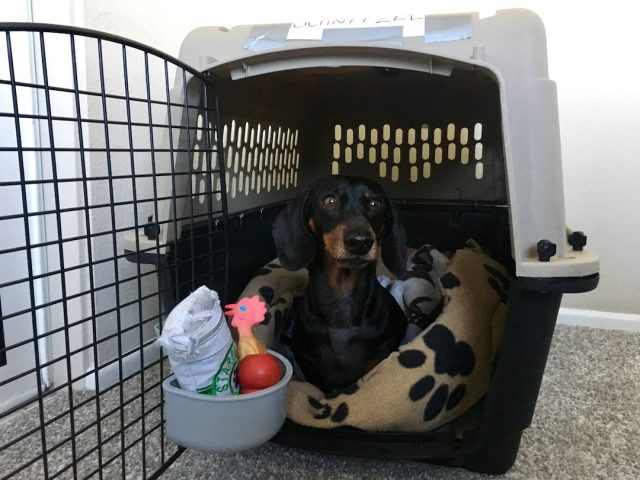
Choosing a Dog Carrier Bag for the Cabin
If you plan to fly with your dog in the cabin, they will require a pet carrier bag to travel in, unless they are a service animal or emotional support animal. Your dog may also need to stay in the carrier bag when inside the airport, depending on the airport.
Each airline specifies their own guidelines for pet carrier bags, but generally they are quite similar. Typically the bag will need to be well ventilated, leak-proof and able to be fully zipped up. Soft carrier bags are usually recommended. However, the maximum dimensions often differ from airline to airline.
In my experience, airlines don’t measure the dimensions of your pet’s carrier bag at check-in, being more likely to just weigh the bag if a maximum weight has been specified. I’ve previously flown with my pet on flights where my carrier bag slightly exceeds the limit, and have had no issues as it is soft and can be slightly squished down if necessary.
For more details of the requirements of carrier bags and some recommendations, check out my guide to choosing a dog carrier for plane travel, including a discussion of the new possible requirement for bags to have mesh on all four sides.
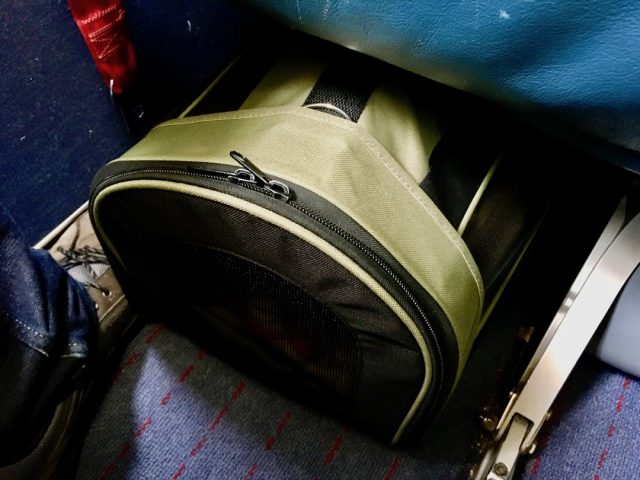
Choosing a Dog Crate for the Hold
The crates used for dogs to fly in the hold of planes are quite different to the carrier bags required in the cabin: large and sturdy rather than small and soft. The guidelines for dog crates in the hold are specified by IATA, the International Air Transport Association, although some airlines might have some extra requirements.
The size of the crate required for your pet depends on their dimensions. Follow the guidelines specified here, plus keep in mind this is just a minimum. If possible, I recommend personally testing the crate with your dog inside it before buying it, to ensure it is adequate.
Your pet’s crate also needs a fitted water bowl with a funnel or water bottle on the outside, and usually two-part plastic containers must have the top and bottom secured by screws or nuts and bolts, rather than plastic clips. Check with your airline for their preferences on including a soft toy or blanket, plus providing food.
One downside to the crates used to transport dogs in the hold is that they are very bulky. This makes them difficult to transport (and store) before or after the flight. I’ve usually had to take apart the crate I’ve used for my small Miniature Dachshund to fit it into a small car. You might be able to get around this by hiring a crate a pet transport company, if you use one.
Getting a Pet Health Certificate
Many airlines require pets to have a pet health certificate in order to board a flight, whether flying in the cabin or in the hold. Also called a “fit to fly certificate”, this confirms that the pet is in good health and fine for air travel.
If flying to an international destination, you may already need to get a pet health certificate depending on the required paperwork for your destination. This health certificate can also be used for the airline.
However, if you don’t require a pet health certificate for the route, make sure you still check with the airline. This requirement is usually listed on their website, or can be confirmed through the call centre.
Generally, the pet health certificate should be issued within a certain number of days of the flight – check with the airline.
Preparations on the Day of the Flight
On the day of the flight, also make sure you prepare your dog for the flight.
One of my top tips is to take them for a walk, to help tire them out and increase the likelihood that they just sleep through the flight. Go light on meals, ideally not feeding them in the few hours before the flight. And always toilet them as close to the flight as possible, either at a pet relief area or before entering the terminal or dropping them off at the freight facility.
It also helps to carefully choose the best time of day to fly with your dog. For shorter flights, try to avoid disrupting their usual meal times or walk times, especially if they are sticklers for routine. For longer flights I actually prefer night time flights, as my dog is happier to just sleep through the entire flight and not need to toilet.
Flying with Pets Around the World
Find out more about flying with pets in different parts of the world…
Flying with a Pet in Europe

The majority of airlines in Europe permit dogs to fly in the cabin and in the hold as checked baggage. The main exception are some of the budget airlines, with both Ryanair and Easyjet not allowing pets to fly, only service dogs. Additionally, some airlines only permit pets to fly in the cabin, not in the hold.
To find airlines in Europe that will fly your dog in the cabin, check out my listing of European airlines that allow dogs in the cabin. I’ve also put together an extensive guide on flying with a pet in the cabin in Europe, based on my many flights during my travels in Europe.
Note that in Europe every airline stipulates a maximum weight for pets flying in the cabin (including their carrier). This is usually 8kg (17.5 pounds), but a handful of airlines restrict it to 6kg (13 pounds) or permit 10kg (22 pounds).
The main exception to the acceptance of pets flying in Europe is the United Kingdom. In the United Kingdom, dogs are not allowed to fly in the cabin. When flying into the United Kingdom, pets must also fly as cargo, although this rule is relaxed for pets flying out of the UK, albeit only limited airlines provide the option – see my listing of the airlines that fly pets out of the UK. If you are flying in the UK, read my article about pets on UK airlines.
Unfortunately, one area where Europe lags is in the dog-friendliness of airports. Unlike in the USA, most airports don’t have pet relief areas. On the other hand, most airports do have nice grassed areas just outside of the terminal, and you don’t need to check in as early when flying within the Schengen zone. Read more in my post about how dog-friendly European airports are, although there are indications this is gradually improving.
Flying with a Pet in the USA

In the United States, all of the major airlines permit dogs on planes, at least in the cabin. For a complete guide to their pet policies, set my listing of American airlines that allow pets in the cabin, covering both North and South America. I’ve also put together a guide to inter-island flights in Hawaii, including pet policies.
When pets fly in the cabin, some of the United States airlines don’t stipulate a maximum weight for your pet, just maximum dimensions. When maximum weights are stipulated, they are often higher, including a very high 40 pounds (18kg) for Spirit Airlines. However, you should still make sure your pet has sufficient room in the bag, including to sit up, lie down and turn around.
There’s a higher awareness of the needs and humane treatment of flying animals in the United States. Virtually every airport in the United States, at least the major ones, have pet relief facilities. Check on the airport website if you want to find out the location in advance, with at least one location usually being gate side.
Additionally, many airports in the hotter regions of the USA ban the transport of animals in the hold, both departures and arrivals, during the warmer months. Investigate this in advance if it might apply to you.
Flying with a Pet in Australia
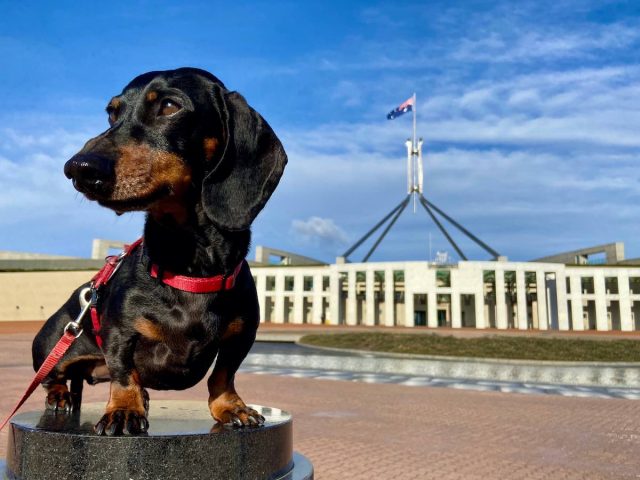
In Australia, pets are not often flown, except for puppies being re-homed or families relocating internationally. This is mainly due to government regulations. Up until late 2021, pets were not permitted to fly in the cabins of planes, only recognised service animals. However, it is now up to individual airline, although no domestic airlines have yet started allowing pets in the cabin.
For now, pets flying in Australia are required to fly in the hold. Also, when flying into the country, pets are required to fly as cargo, not in the cabin, unless on chartered flights. There’s a long list of additional requirements for pets arriving in the country, including flying into Melbourne to go into quarantine. Within the country pets are usually also flown as cargo.
Both of the major airlines in Australia, Qantas and Virgin Australia, transport pets with their freight divisions on the majority of their routes. The smaller Regional Express (REX) also transports pets. With REX, within NSW and Victoria pets are flown as checked baggage, while additional arrangements apply in other states. The budget airline Jetstar does not transport pets.
For more information, see my extensive guide on flying with pets in Australia, or also see my post about importing my dog back into Australia.
How to Fly a Dog Around the World
To fly with your pet around the world isn’t that different to flying with them across a country. The main difference is that some airlines have maximum flight durations for pets being allowed in the cabin, in particular some of the US airlines, so pets are more likely to be flown in the hold.
Some other countries may also require pets to travel in cargo, often with a booking through a pet transport company, on international flights.
To find out more about the options available for flying across the Atlantic, read this post about flying a dog from the USA to Europe. Also check out this post about the experience for one couple flying their dog from Thailand to Europe.
About the Author

Shandos Cleaver is the founder of Travelnuity: Dog-Friendly Travel. She has travelled extensively with her Miniature Dachshund, Schnitzel, including to 33 countries across Europe, every state and territory of Australia except Tasmania, and 10 of the United States. She’s passionate about providing inspiration and information to others wanting to travel with their dogs, whether close to home or internationally.
Inspired? Pin this to your Pinterest board!
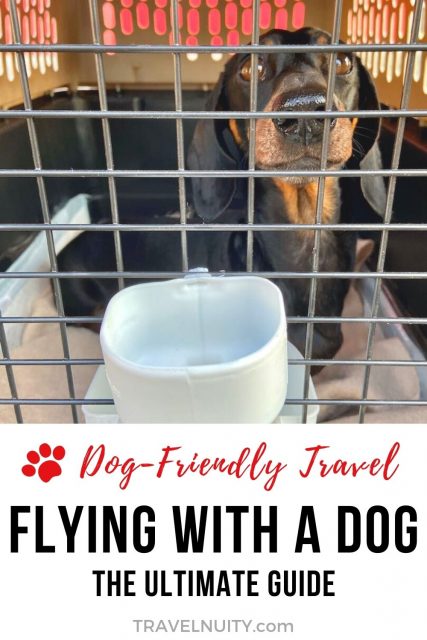

I have a Dachshund who is very stubborn and hates harnesses, leashes, clothing of any sort, the vet, etc. She has never been on a plane nevermind in a carrier. I am certain she will hate that and I don’t want her to stress the entire time. I won’t get on the plane if she is too stressed out. I plan to have the vet give her something to make her relaxed but I know my baby, and I am so afraid that she will freak out mid flight! I am a wreck.
She will get the carrier tomorrow (borrowing from a friend) and the dog smell will be familiar to her. I will put in a tee shirt of mine so that might help.
Any other tips/suggestions?
It’s best to spend as long as possible getting her used to the carrier. Encourage her to spend time in the carrier, sleep in it, etc. It’s a good idea to feed her in the carrier, or at least give her treats in it, to encourage her to feel positive about it. Many Dachshunds and other small dogs really enjoy having a cosy “home” that is a safe place for them, so hopefully she adopts it.
I would like to fly from the USA to Europe with my 7 pound dog. I wanted to treat myself to a once-in-a-lifetime business or first class ticket, but cannot find any airline that allows pets in those classes flying over the Atlantic. Any suggestions? Thank you.
It’s tricky to find options, as so many airlines don’t allow pets in business or first class, and they don’t always detail it online. One good option is La Compagnie (https://www.lacompagnie.com), a business class only airline that flies to France, and is quite pet-friendly.
Thank you so much. I think I’ve read all your blogs and enjoyed them. Very informative.
Thanks Peg!
Turkish Airlines